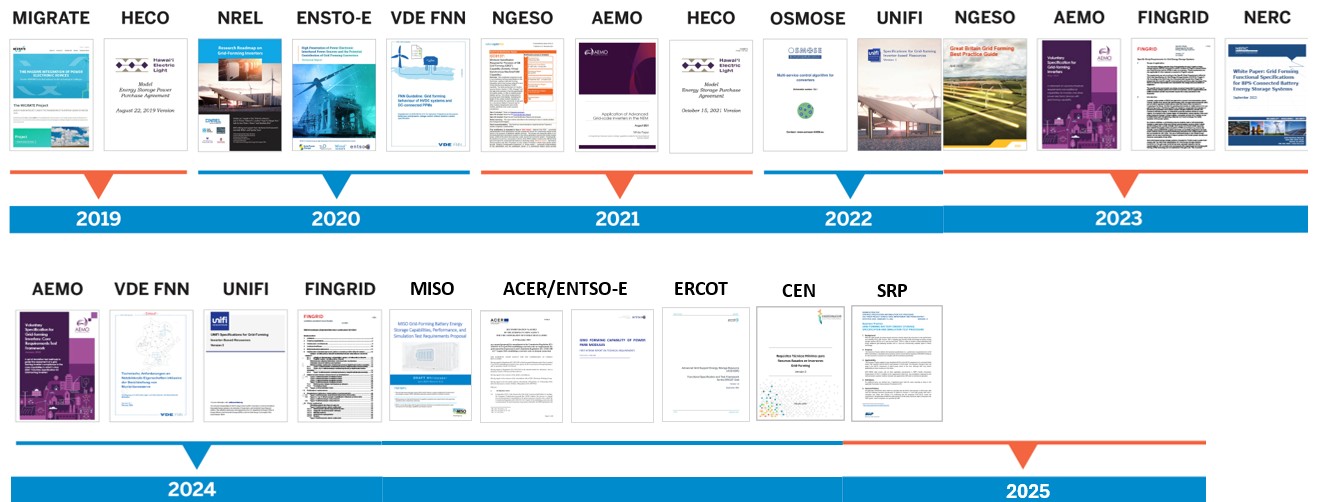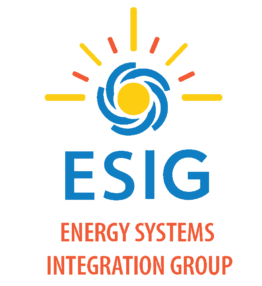One step toward breaking the chicken-and-egg problem of wider deployment of GFM IBRs is the development of clear technical specifications for grid-forming capability and performance. Such specifications provide more certainty and clarity to manufacturers, informing their research and development process. Some system operators and research and regulatory organizations have already published their versions of technical requirements for GFM capability. This page tracks most recent versions of these requirements.
The graphic below gives the landscape of grid-forming specifications at a glance:

-
- MIGRATE: EU-funded project on the Massive Integration of Power Electronic Devices (2019)
- Hawaiian Electric Company (HECO): Model Energy Storage Power Purchase Agreement (draft) (2019)
- National Renewable Energy Laboratory (NREL): Research Roadmap on Grid-Forming Inverters (2020)
- European Network of Transmission System Operators for Electricity (ENTSO-E): High Penetration of Power Electronic Interfaced Power Sources and the Potential Contribution of Grid-Forming Converters (2020)
- VDE FNN: Guideline Grid-Forming Behavior of HVDC Systems and DC-Connected PPMs (2020)
- National Grid Electricity System Operator (NGESO): GC0137: Minimum Specification Required for Provision of GB Grid Forming (GBGF) Capability (2021)
- Australian Energy Market Operator (AEMO): Application of Advanced Grid-Scale Inverters in the NEM (2021)
- Hawaiian Electric Company (HECO): Model Energy Storage Power Purchase Agreement (2021)
- OSMOSE: OSMOSE (Optimal System Mix of Flexibility Solutions for European Electricity) Overall Specifications of the Demonstrations (2021)
- National Grid Electricity System Operator (NGESO): Great Britain Grid Forming Best Practice Guide (2023)
- Australian Energy Market Operator (AEMO): Voluntary Specification for Grid-Forming Inverters (2023)
- FINGRID: Specific Study Requirements for Grid Energy Storage Systems (2023)
- North American Electric Reliability Corporation (NERC): Grid Forming Functional Specifications for BPS-Connected Battery Energy Systems (2023)
- Australian Energy Market Operator (AEMO): Voluntary Specification for Grid-Forming Inverters: Core Requirements Test Framework (2024)
- VDE FNN: Technische Anforderungen an Netzbildende Eigenschaften inklusive der Bereitstellung von Momentanreserve (2024)
- UNIFI: Specifications for Grid-forming Inverter-based Resources, Version 2 (2024)
- Midcontinent Independent System Operator (MISO): MISO Grid-Forming Battery Energy Storage Capabilities, Performance, and Simulation Test Requirements Proposal (2024)
- ACER: Recommendation No 03/2023 of the European Union Agency for the Cooperation of Energy Regulators (2023)
- European Network of Transmission System Operators for Electricity (ENTSO-E): Grid Forming Capability of Power Park Modules: First Interim Report on Technical Requirements (2024)
- Electric Reliability Council of Texas (ERCOT): Advanced Grid Support Energy Storage Resource (AGS-ESR) Functional Specification and Test Framework for the ERCOT Grid, Version 1.0 (2024)
- CEN: Requisitos Técnicos Mínimos para Recursos Basados en Inversores Grid-Forming (2024)
- Salt River Project: Business Practice on Grid Forming Battery Energy Storage System Specification and Simulation Test Procedures (2025)
- FINGRID: Grid Code Specifications for Grid Energy Storage Systems SJV2024 (2025)
The specifications can be further differentiated into those defined and enforced by a system operator or a regulatory body and those defined by a research organization or an industry working group, in the form of recommendation to whomever has authority to specify interconnection requirements.The requirements above include the following elements:
- High level vs. detailed functional specifications
- Functional specifications vs. test-based vs. both
- Split into “core” and advanced capabilities vs. not split
- Voluntary vs. mandatory
- For all resources vs. all IBRs vs. just battery energy storage (recognizing that the latter is lower-hanging fruit for GFM application)
The ESIG webinar “Overview of Grid Forming Interconnection Requirements” from September 2023 provides a high-level overview of the specifications available at that point in time.
The Global Power System Transformation Consortium’s document Summary of GFM Capability and Performance Requirements Driven by System Needs provides a summary and comparison of available grid-forming specifications published through January 2024.
